Search Results for 'Patrick Joyce'
15 results found.
Clutching a candle, Tom Casey withdraws his evidence
The horrific Maamtrasna murders, the arrest of 10 men, the rush to ‘justice’, the evidence of the Cappanacrehas (known to be bitter enemies of the murdered Joyces), the two informers Anthony Philbin and Thomas Casey (whose false evidence led to penal servitude for life for five innocent men, and the execution of one innocent man), was followed in minute detail not only throughout Ireland, but in Britain and among the Irish communities in America. Yet nowhere did it impact more than on the mountainside community of Maamtrasna .
An extraordinary confession on the eve of execution

The brutal killing of the Joyce family, the subsequent round up of the 10 accused, their trial and the sentencing of three men to hang, while the rest pleaded guilty and faced a life of penal servitude, gripped the public yet again when it had barely recovered from the Phoenix Park murders. In particular the evidence by the Cappanacrehas, and by Philbin and Casey understandably caused deadly resentment in Connemara, which still finds an echo today.
The police were told ‘an astonishing tale’
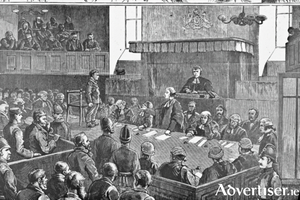
Then on August 17 the so called Maamtrasna Murders were committed. It was a crime that the local police dreaded not only because of its horrific nature, but because of the unlikelihood that the perpetrators would ever be found. Usually in a closeknit community, such as at Maamtrasna , the murderers would never be revealed, at least never to the police.
An outburst of unredeemed and inexplicable savagery
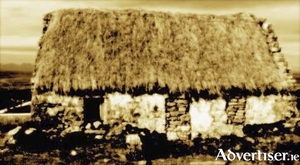
In early October 1884 a journalist from The New York Times, whom we only know by his initials HF, left Galway for Cong by steamer, in the company of Mr TP O'Connor, MP for Galway, and Mr Healy, MP for Monaghan.
Wild nights of burning and murder
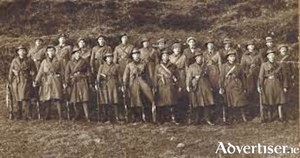
Clifden was not the only town to experience the terror of British forces running wild, shooting, and setting fire to buildings. The previous year, July 19 1920, Tuam suffered a similar experience as Clifden, only mercifully no resident was killed on that occasion.
The unveiling of a plaque to Fr Griffin
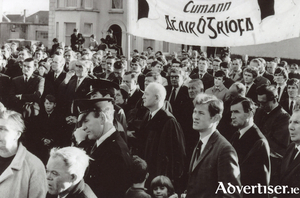
On November 14, 1920, a young curate, Father Michael Griffin, was lured from his house at No 2 Montpellier Terrace by the Black and Tans. Whatever ruse they used to get him out of the house, it was not to go on a sick call, as he did not take the holy oils or the Eucharist with him, but went peacefully. He went missing and volunteers and search parties were organised and combed the city and surrounding countryside looking for him. A week later his body was found buried in a bog at Cloch Sgoilte in Barna. There was an international outcry. He had worked in the parish of Rahoon since June 1918 and was hugely popular. He spoke in Irish to young and old, organised feiseanna, currach races, and donkey races on Silver Strand. He was very republican and was suspected by the Tans of having heard the last confession of the informer Patrick Joyce, which was probably the reason why they abducted him and tried to extract the identity of Joyce's killers from him.
Father Griffin’s body found
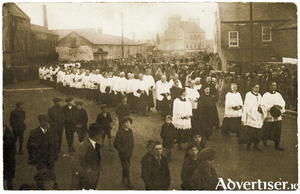
At about 3pm on the afternoon of Saturday, November 20, 1920, William Duffy of Cloghscoilte near Barna was driving cattle locally when one of them got stuck in the mud. William noticed part of a coat sticking out of the gap, so he went for his neighbours Patrick and Thomas Lydon, and later Patrick Cloherty and Patrick Concannon from Truskey joined them at what turned out to be a grave. They uncovered part of the body and realised that it was that of Fr Griffin. They decided to wait until it was dark so they covered up the body again, afraid that the Tans might return to remove it. William Duffy rode on horseback into Fr O’Meehan in Montpellier Terrace to inform him of the tragedy. Fr O’Meehan, Fr Sexton, and Canon Considine then hired Patsy Flaherty’s side car and went out to Clochscoilte.
Father Michael Griffin

Michael Joseph Griffin was born on September 18, 1892, in Gurteen in east Galway, one of five children of Thomas Griffin and Mary Kyne. He was educated locally, then in St Joseph’s College, Ballinasloe, and finally in Maynooth. He was ordained in April 1917 and was seconded to the Galway diocese. He worked for a year in Ennistymon and in June 1918 was transferred to the parish of Rahoon which stretched from the river out to Furbo and Corcullen. He developed a great rapport with the children of the parish, spoke in Irish to young and old, organised feiseanna, currach races, and donkey races on Silver Strand.
Patrick Joyce

Patrick Joyce was born at Lisheenagaoithe, near Headford, on May 23, 1868. He became a monitor teacher in 1884, taught in Cloghanover School for two years, later as principal of Trabane, and then Tiernee in the parish of Carraroe. In 1892 he married Margaret Donohue. He was eventually appointed as principal of Barna National School and his wife taught in Boleybeg National School.
‘Muishe, is it yourself that’s in it, Mr O’Brien?’
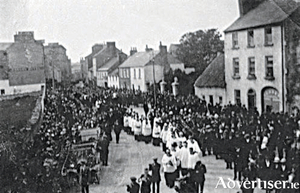
Liam Ó Briain, professor of romance languages UCG, was arrested by the Black and Tans on November 21 1920. He was taken to the RIC barracks, at that time in Dominick Street, and then up to the army barracks at Earls island, where he was identified. Other men arrested stood in line. They were watched by ‘pompous young officers’ who, with ‘a hand on their guns’ ‘sniggered’ at the standing prisoners. They went up and down pulling hands out of their pockets. Ó Briain, in his recently published essays on his experiences,* did not sound too concerned. He was well known to the police authorities. Because of the murder and mayhem during the week of his arrest, he must have been expecting to be picked up.

